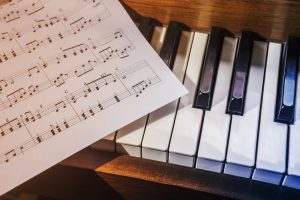Table of Contents
Astor Piazzolla (new sheet music Dec. 2024)
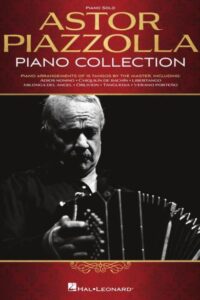
Best Sheet Music download from our Library.
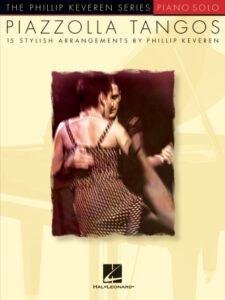
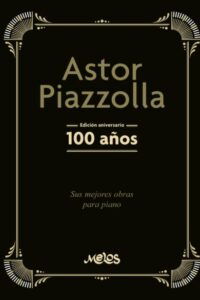
Descarga las mejores partituras de nuestra biblioteca.
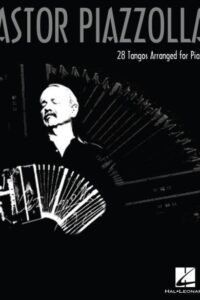
Please, subscribe to our Library.
If you are already a subscriber, please, check our NEW SCORES’ page every month for new sheet music. THANK YOU!
You can check all the NEW sheet music on this page.
About Astor Piazzolla
Astor Piazzolla is not only the most famous tango musician in the world, but also a composer cultivated by notable international concert artists, chamber ensembles and symphony orchestras. It is possible that he took tango to its limits, so far—aesthetically speaking—that many tango players were unable to accompany him or understand him. To those who did follow him, and to those who came after him, he bequeathed the difficult problem of escaping, even in part, from his influence and finding a new direction after his work. Postpiazzollism until now is a collection of attempts, some important but insufficient.
His insertion into the tango scene of Buenos Aires began in 1938, precisely the time when tango was rapidly awakening from its relative lethargy, which began around 1930. Astor Piazzolla ‘s relationship with that scene was complicated, a mixture of love and contempt, of admiration and resentment. But his fight, which was that of an artist as gifted as he was innovative, against mediocrity and conservatism, was waged from within tango, with deep roots in it, playing with other or his own orchestras in café boxes or in dark clubs. suburban. The post-Piazzollanos no longer have this mud in their boots.
Despite this roots and the deep tango essence of everything Astor did, even when it was about other music, since the mid-1950s a supposedly disqualifying catchphrase spread among his detractors: “Piazzolla is not tango,” as an expression. absolute of quietism and intolerance. Despite this antagonism, several tangos were written in tribute to him, one of them by Julio De Caro , a capitular figure of the genre, testifying to the admiration aroused by this harsh and combative character, who broke all the molds.
Astor Pantaleón was born in 1921 in Mar del Plata, when this fishing port on the Atlantic, 420 kilometers south of Buenos Aires, was at the same time an aristocratic resort, not yet massive. In 1924 he went to live with his parents in New York, where in 1929 his encounter with the bandoneon occurred. In 1932 he composed his first tango, “La catinga”, never released, and appeared as a child actor in El día que me Quiero , a film whose star was Carlos Gardel .
Back in Mar del Plata, in 1936 he began to join local groups and even lead one that adopted the style of the Vardaro Sextet, which from 1933 had attempted a bold stylistic improvement, disdained by recorders. Their leader, the violinist Elvino Vardaro , would play many years later for Piazzolla.
In 1938 he arrived in Buenos Aires, where, after briefly passing through several orchestras, he was incorporated into that of the bandoneonist Aníbal Troilo , which had been established in 1937 and played a transcendental role in the heyday of tango in the following two decades. In addition to being a bandoneon player, Astor was an arranger and occasional pianist there, in a hurry to replace Orlando Goñi (or Gogni), as brilliant as he was a failure. Troilo adopted Piazzolla, but he also curtailed his flight to limit it to the limits of his style, which should not go beyond the capacity of the popular ear.
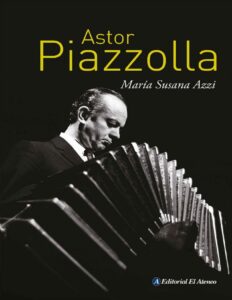
Astor’s innovative impetus began to unfold in 1944, when he left Troilo to conduct the orchestra that was to accompany the singer Francisco Fiorentino . That was the extraordinary conjunction of an enormously popular vocalist and a uniquely talented musician. Of that pairing, 24 recorded songs remained, with outstanding versions (the tangos “ Nos nos en paso ”, “ Ovie Viejo Blind ” and “ Volvió una noche ”, among others). The series includes the first two instrumentals recorded by Piazzolla: the tangos “ La chiflada ” and “ Color de rosa ”.
After that inaugural experience, Astor launched his own orchestra in 1946, still adjusted to the traditional canons of the genre. As such, it was established from its beginning among the most advanced groups, along with those of Horacio Salgán , Francini-Pontier , Osvaldo Pugliese , Alfredo Gobbi and Troilo himself. Among its singers, Aldo Campoamor stood out . Until 1948 he recorded a total of 30 songs, including anthological versions of tangos such as “ Taconeonando ”, “ Institución ”, “ Tierra querida ”, “ La rayuela ” or “ El recodo ”. Among the records, five works by Piazzolla himself stand out, which already announce – particularly in the cases of “ Pygmalión ” and “Villeguita” – the brilliant composer.
This emerges very soon in all its depth and originality with tangos of unparalleled inspiration: “ To Lucre ”, “ Preparense ”, “ Contratiempo ”, “ Triunfal ”, “ Contratiempo ” and “ What will come ”. These pieces are incorporated into the repertoire of important orchestras, such as those of Troilo, Francini-Pontier , Osvaldo Fresedo and José Basso , often with arrangements written by Piazzolla himself. Meanwhile, his orchestra recorded four works between 1950 and 1951, two of them on a memorable 78-revolution record: the old tangos “ Triste ” and “ Chiqué ”.
In the early 1950s Piazzolla hesitated between the bandoneon and the piano, and thought of turning to classical music, in which he had already been dabbling as a composer. With these ideas he moved to France in 1954, with a scholarship from the Paris Conservatory, but the musicologist Nadia Boulanger persuaded him to develop his art based on what was most his own: tango and bandoneon. There he recorded in 1955, with the strings of the Paris Opera Orchestra, Martial Solal on piano and himself on bandoneon, 16 songs, all his own except two. That was a new torrent of amazing melopéa, with tangos like “ Nonino ” (forerunner of the famous “Adiós, Nonino”, an emotional farewell to the death of his father), “ Marrón y azul ”, “Bye Paris”, “Bandó”, “Picasso” and others.
Back in Argentina, Piazzolla would be deployed in two directions. On the one hand, the bandoneon and string orchestra, with which he unveiled a new generation of his tangos, with an already disruptive attitude, such as “Three minutes with reality”, “ Tango del Ángel ” and “Melancólico Buenos Aires”. His repertoire at that time also included reread traditional tangos and more current ones by different musicians, such as “ Negracha ” (Pugliese), “ Del Bajo Fondo ” ( José Tarantino and Osvaldo Tarantino) or “ Vanguardista ” (José Bragato). The orchestra had the singer Jorge Sobral , since Astor wanted to extend his innovative proposal to tango song.

Piazzolla’s other great company at that time was the creation of the Octeto Buenos Aires, in which he brought together high-level performers and with which he subverted everything known in tango until then. There are those who judge this Octet as the artistic zenith of his entire career. That group, which recorded only two medium long-plays, dedicated itself above all to reinterpreting great traditional tangos, such as “ El Marne ”, “ Los marados ”, “ Mi refuge ” or “ Arrabal ”.
In 1958, Piazzolla settled in New York, where he experienced very difficult circumstances. From that unhappy stage remained his jazz-tango experiment, which he himself judged harshly—perhaps excessively—due to the commercial concession it entailed. But upon returning to Buenos Aires in 1960 he created another of the fundamental ensembles of his career: the Quinteto Nuevo Tango (bandoneon, piano, violin, electric guitar and double bass), which caused a sensation among certain segments of the public, including university students.
This formation, whose members changed over time, frequented a varied repertoire, which included new tangos by the director, such as “ Adiós Nonino ”, “ Decarísimo ”, “ Calambre ”, “Los Poseídos”, “Introduction to the Angel”, “Muerte del Ángel”, “ Revirado ”, “Buenos Aires Hora Cero” and “ Fracanapa ”, among others. With the voice of Héctor De Rosas he performed notable versions of “ Milonga triste ” and tangos such as “ Cafetín de Buenos Aires ”, “ Maquillaje ”, “ Nostalgias ” and “ Cuestabajo ”, among others.
In 1963, he returned to a fleeting New Octet, which did not reach the optimal level of the previous one but allowed him to incorporate new timbres (flute, percussion, voice). Among the various achievements of those intense years, two events from 1965 stand out. One is the concert that he gave with the Quintet at the Philharmonic Hall of New York, publicizing the Devil Series and the completed Angel Series , in addition to “The mufa.” At the same time, he recorded in Buenos Aires a series of his exceptional compositions based on poems and texts by Jorge Luis Borges (with his mythology of suburban cutlers), with the singer Edmundo Rivero and the actor Luis Medina Castro. That same year he released “ Versa porteño ”, the first of the invaluable tangos that will make up the Cuatro Seasons .
He then began his production with the poet Horacio Ferrer , with whom he created the opera María de Buenos Aires (which includes the admirable “ Fugue and mystery ”) and a succession of tangos. In 1969 they released “ Balada para un loco ” and “ Chiquilín de Bachín ”, which suddenly gave Piazzolla massive hits, to which he was not accustomed. That year he recorded them twice, with the singer Amelita Baltar and with the singer Roberto Goyeneche.

the previous year In 1972, in another great moment for Piazzolla and after having recorded the magnificent LP Concert for Quintet , he formed Conjunto 9, with which he recorded Contemporary Music from the City of Buenos Aires , as if transcending the discussion on tanguity. The albums that this nonet made include the outstanding “Tristezas de un Doble A”, “Vardarito” and “Onda nine”. After leaving Argentina again, Astor began his fruitful Italian stage, where among other works he released “ Balada para mi muerte ”, with the singer Milva , “ Libertango ” and the moving “Suite troileana”, which he wrote in 1975 under the impact what the news of Troilo’s death caused him.
Three years later he composed and recorded with orchestra a series of works dedicated to the world soccer championship, this time held in Argentina, during the bloody military dictatorship established in 1976, which politically manipulated that tournament. This was a deplorable misstep by Piazzolla.
In 1979, again with his quintet, he presented “ Escualo ”, among other songs. Throughout those years and the following, Astor combined his talent with artists of diverse origins, such as George Moustaki (for whom he composed the beautiful songs “Making This Song” and “The Memory”), Gerry Mulligan and Gary Burton. Among other varied performances, the album included an apotheotic performance by the quintet in 1987 in New York’s Central Park. Piazzolla’s last formation was a sextet, which added a second bandoneon to the quintet and replaced the violin with the cello.
In addition to concert works and music for nearly 40 films, Astor conceived numerous short pieces (tangos or not) omitted from this brief review. Among them are “Juan Sebastián Arolas”, “ Contrabajeando ” (written with Troilo), “Tanguísimo”, “La calle 92”, “ Oblivion ”, “ Years of loneliness ”, “ The lost birds ”, “Lunfardo”, “ Baillongo ” ”, “ Vuelvo al sur ” and the series La camorra . Diving into Piazzolla’s immense work, finding scores and arrangements or devising new ones is today the fascinating task of musicians from all over the world.
Verano Porteño (by Astor Piazzolla)
Streaming desde el Teatro Piazzolla de Buenos Aires para el Center for the Art of Performance de la Universidad de California, Los Angeles (CAP-UCLA), November 2020, QUINTETO ASTOR PIAZZOLLA.
Browse in the Library:
Or browse in the categories menus & download the Library Catalog PDF:
